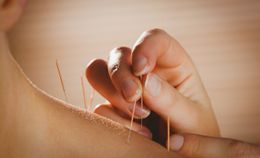There are many reasons you might be considering acupuncture and benefits to treatment. As you begin to understand how acupuncture works, it is also important to understand the potential risks and side effects associated with acupuncture.
When it comes to risks and side effects of acupuncture, it is shown through a study by the Acupuncture in Medicine that the risks connected to acupuncture are lower especially compared to the risks involved with other common medical treatments.
Table of Contents
Is Acupuncture Safe?
Further Evidence
The FDA and Acupuncture
4 Ways Acupuncture may Pose a Risk
Statistics
6 questions to ask Practitioners
The Bottom Line
References
Is Acupuncture Safe?
According to a study conducted by the Family Medicine Journal, acupuncture is a safe form of treatment as long as the practitioner performing the acupuncture treatment has a solid, "knowledge of normal anatomy and anatomical variations is essential for safe practice and should be reviewed by regulatory bodies and those responsible for training courses".
Further evidence
The correlation between avoiding risks and side effects and practitioner knowledge base is further supported by research done by the Royal Society of Medicine. Their research shows that, "In the hands of well-trained, experienced acupuncturists, serious events seem to occur rarely".
The FDA and acupuncture
To enhance the safety of acupuncture treatment there are regulations the U.S. Food and Drug Administration (FDA) has a section of regulations on acupuncture needles. The regulations in place have been in use since 1996 and their purpose is to act as preventive measures for reducing the level of side effects and risks for people choosing acupuncture as a treatment. There are three special controls that are mandated by the FDA to be followed by acupuncture practitioners:
-
Use: Each needle may only be used for a single use. The needs need to be labeled as one-time use.
-
Material: Every needle needs to be made from a material that is biocompatible and non-toxic.
-
Sterile: All needs used by practitioners need to have a high level of cleanliness and sterilized.
4 Ways Acupuncture May Pose a Risk
All the same, acupuncture does have risks and side effects. There is one main factor that increase the possibility of the associated risks and side effects of acupuncture is the manner in which acupuncture treatment is carried out. If it is done properly the chances of experiencing risks and side effects are low. If the manner in which the acupuncture is performed and carried out is not correct, the risk level goes up. Here is a list of ways acupuncture may pose a risk and the side effects you need be aware of:
-
Non-sterile needles: Hepatitis B and other infections may be contracted if the needles used are not sterile.
-
Improper placement: Internal organ damage, or a collapsed lung may be experienced if a needle is placed too deep or in the wrong position.
-
Effective needles: If a needle breaks, it may become stuck externally or internally within a part of your body.
-
Insertion: Bruising, bleeding, and general soreness are all possible even with proper care and placement of needles. Because of this if you are on blood thinners or live with hemophilia or another bleeding disorder acupuncture may not be the best choice for you.
Statistics
Since 1965, occurrences of people experiencing side effects and risks have been documented in scientific journals and literature.
Here is a list of statistics about acupuncture side effects and risks:
-
Collapsed lung: Pneumothorax or a collapsed lung has been reported in 23 cases .
-
Nervous system and spinal cord: There have been 10 documented cases of spinal cord injuries.
-
Death: 90 deaths have been documented. Interestingly, none of them have occurred in Great Britain. The deaths often occurred because an acupuncture needed penetrated an important organ.
6 questions to ask practitioners
The acupuncture practitioner that you decide to go to for treatment is everything when it comes to your chances of experiencing the risks and side effects connected to acupuncture. Here are five questions to ask acupuncture practitioners when you are first calling or interviewing them to see if they are a good fit for you and your needs when it comes to minimizing risk level for yourself:
-
Training: Can you tell me about the acupuncture training that you took?
-
Experience: Can you tell me about your experience as an acupuncturist?
-
Knowledge: What can you tell me about your understanding of normal and anatomy and anatomical variations?
-
CCOAM: Is your training accredited by the Council of Colleges ofAcupuncture and Oriental Medicine ( CCOAM)?
-
Preparedness: What protocols and policies do you have in place in case of side effects as treatment is being given?
-
Communication: Can you tell me what I should be on the lookout for after treatment for possible side effects afterwards?
The Bottom Line
Acupuncture is a form of treatment that can serve many people with many different alignments. It does come with side effects and risks that range from mild to severe complications. When practitioners follow FDA acupuncture needle guidelines, and you questions before selecting a acupuncture treatment practitioner you are taking steps to reduce your risk level all while pursuing a treatment option that may help you.
References
Acupuncture: In Depth. (2017, February 21). Retrieved June 12, 2018, from https://nccih.nih.gov/health/acupuncture/introduction#hed4
CFR - Code of Federal Regulations Title 21. (n.d.). Retrieved June 12, 2018, from https://www.accessdata.fda.gov/scripts/cdrh/cfdocs/cfcfr/CFRSearch.cfm?fr=880.5580&SearchTerm=acupuncture
De, M. (2001, October). [Acupuncture: Complications, contraindications and informed consent]. Retrieved June 12, 2018, from https://www.ncbi.nlm.nih.gov/pubmed/11694754
Ernst, E. (2010, October 01). Acupuncture - a treatment to die for? Retrieved June 12, 2018, from https://www.ncbi.nlm.nih.gov/pmc/articles/PMC2951167/
Peuker, E. T., White, A., Ernst, E., Pera, F., & Filler, T. J. (n.d.). Traumatic complications of acupuncture. Therapists need to know human anatomy. Retrieved June 12, 2018, from https://www.ncbi.nlm.nih.gov/pubmed/10575398
Peuker, E., & Gronemeyer, D. (2001, December 01). Rare but serious complications of acupuncture: Traumatic lesions. Retrieved June 12, 2018, from http://aim.bmj.com/content/19/2/103.long





















